
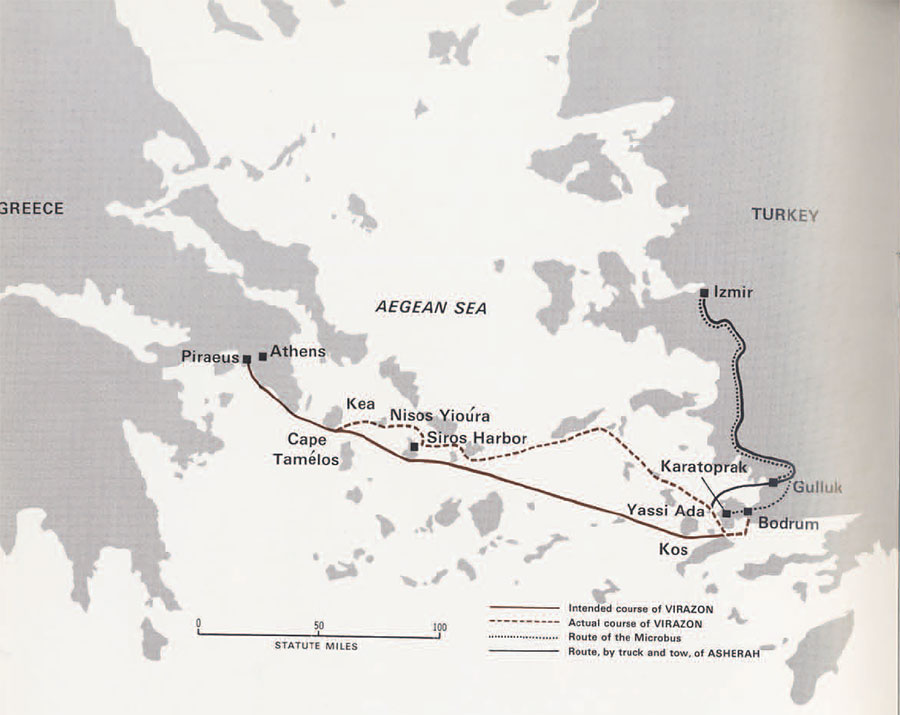
By George F. Bass
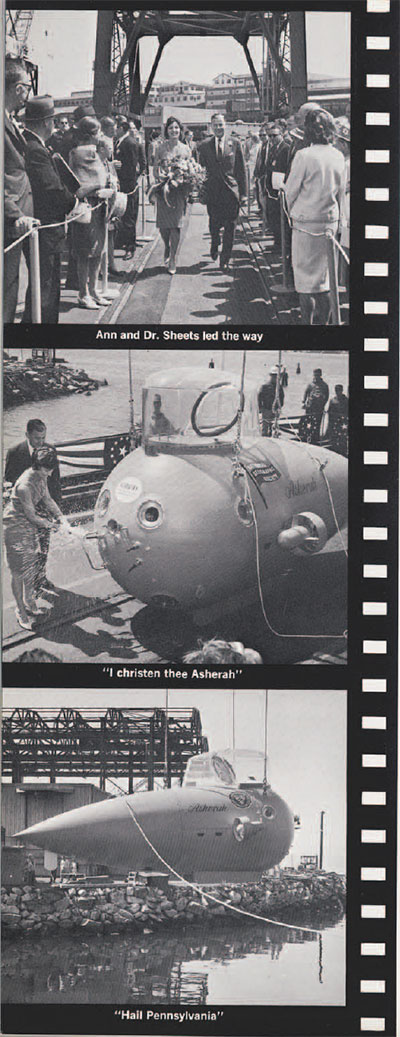
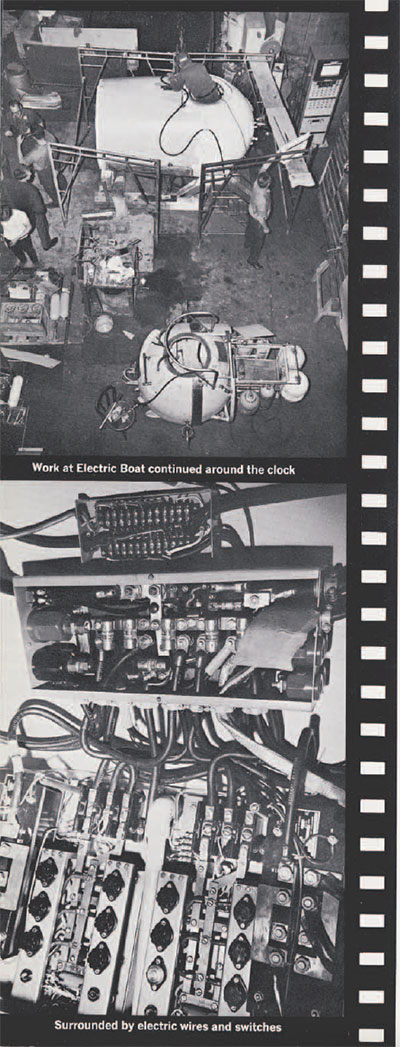
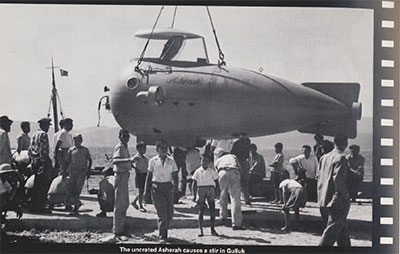
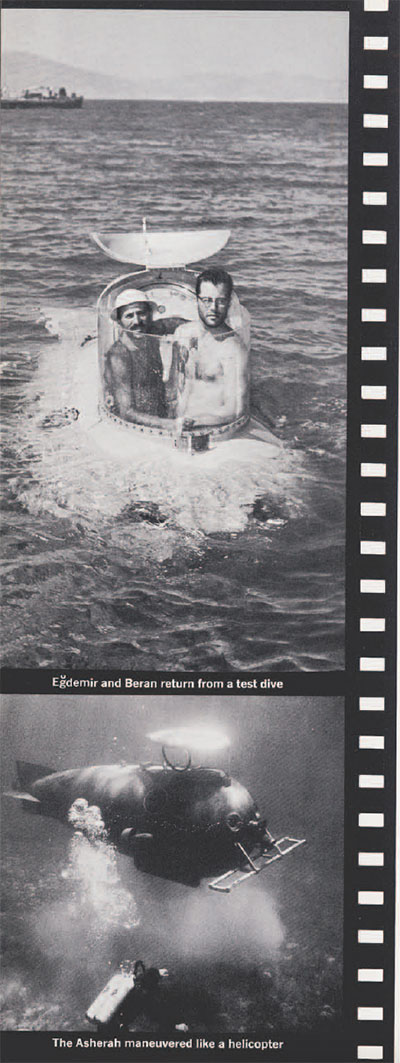
It was surely the most exciting day of my life. When I stepped from the limousine I wondered if I would look in vain for a few familiar faces. But as we walked the length of the graving dock, I picked out Dr. Kidder and Dr. Young and so many of the curators of the University Museum and their wives. Members of the Museum’s Women’s Committee were there, and Mr. James Magill represented the Museum’s Board of Managers. In the crowd were Dr. Melvin Payne and editors of the National Geographic Society, which had been of such help in our underwater research. Naval officers stood at attention. My wife, Ann, carrying a bouquet of red, white, and blue carnations, led the way, escorted by Dr. Herman Sheets, Chief Research and Development Engineer of the Electric Boat Division of General Dynamics. Flash bulbs popped, and newsreel cameras for the television networks ground. The launching ceremony for the Museum’s new two-man submarine had begun.
Following the invocation by the Division chaplain, Dr. Sheets welcomed the guests and spoke of the importance of the first non-military submarine ever launched by the Electric Boat Company in its sixty-year history; a nuclear Polaris submarine was being built only a few feet away. Telegrams were read. One of the most thrilling was certainly from the Trieste, the bathyscaphe which had gone to the deepest part of the ocean, more than six miles down: “We welcome research vessel Asherah to undersea research. Every success!” signed by Lieutenant Commander Mooney, officer in charge of the Trieste group.
I had been asked to talk for a few minutes, and I tried to convey the archaeological importance of this event:
“During the coming years, our knowledge of man’s past will come increasingly from the sea, for underwater archaeology is more than salvaging ancient wine jars and studying the history of ship construction. Almost any object created by man was carried, at one time or another, by ship, and it is with such objects that archaeologists recreate history. Wrecks full of architectural fragments have been found, and wrecks filled with prehistoric utensils and weapons. Further, most of the major Greek bronze statues we have preserved in our museums today were pulled from beneath the sea.
“But these were all chance finds, located by sponge-divers, sport divers, and fishermen’s nets. Once the wrecks had been found, their mapping and excavation took many slow and laborious years.
“We from the University Museum of the University of Pennsylvania, in four years of underwater excavation, realized the limitations of time and depth placed on divers. We realized that new techniques must be found, and last year greatly speeded the course of our excavation by mapping in three dimensions with stereophotography. This showed so much promise that we could only imagine what might be accomplished if we had the means of going deeper and staying down longer.
“With this submarine, soon to be christened Asherah after a sea-goddess of the Phoenicians, the famed sea travelers, we will have those means. She will soon leave for the Aegean, where, with the cooperation of the Turkish Department of Antiquities, we will begin a search for clues concerning ancient migrations and trading routes, and the history of technology and art.
“This is a long step from the day about five years ago when I first left for Turkey with Mr. Peter Throckmorton, equipped with only a compressor and a handful of diving tanks, and it is appropriate that so many of you here today have made that step possible: To Dr. Kidder and others from the University Museum, to Dr. Payne and those from the National Geographic Society, to the members of our field staff, to Dr. Sheets and the men of Electric Boat Division of General Dynamics, and to those generous friends who have seen value in our project, I want to extend great thanks.”
Ann was led to the submarine, invisible under blue bunting as it rested on the pier. Admiral A.I. McKee, now retired but once the Navy’s chief submarine designer, unzipped the covering and, at the given moment, Ann smashed the traditional bottle of champagne, saying: “I christen thee Asherah.”
I looked again into the crowd and was glad to see Dr. James Pritchard, Curator of the Museum’s biblical Archaeology Section, for it was he who had suggested that we name our new submarine after the Phoenician goddess of the sea.
A large gantry crane lifted the Asherah into the air. The sound of Anchors Aweigh came over the loudspeakers. The submarine was lowered gently into the Thames River, and the Coast Guard Band and chorus changed–much to the surprise of the naval officers–to Hail Pennsylvania. It was windy in Groton, and the American flag, the Red and Blue of Pennsylvania and the famous Blue, Brown and Green of the National Geographic Society all fluttered overhead.
During the following reception, and the trip back to Philadelphia, I thought back to events which led up to May 28, 1964. To the first letter in 1949 from Peter Throckmorton telling about the finds he had made in Turkey, and to the forthcoming excavation of the Bronze Age shipwreck (see Expedition, Winter 1961). To the enticing picture he had shown me of a bronze statue of Demeter, pulled up from two hundred or more feet of water in a sponge-dragger’s net. To the Museum’s excavation of a Byzantine wreck, and the strides we had made in mapping such wrecks underwater. And finally to our idea that it would be possible to map wrecks by underwater “aerial photography,” saving months of diving on each excavation. If we could only go deeper and stay longer. If only we had a submarine!
Waldemar Illing, who had dived with us for four summers, came from Germany and traveled the length and width of America by bus, looking at a wide variety of small submersibles. After long discussions with Mr. Robert Toher and Mr. G.T. Coene of Electric boat, we were convinced that their experience and facilities would produce the most suitable submarine for our purposes. But it was more expensive than most of the models we had considered, and we could only guess what a first experimental season would cost. The Museum’s board of Managers agreed to help, and the National Geographic Society promised to continue its support of our work. The Catherwood Foundation and the Corning Museum of Glass made continued grants, and personal support was given by Mr. William Van Alen, Mr. and Mrs. James Magill, Mr. Nixon Griffis, and other generous friends of the Museum. The National Science Foundation was most helpful, and the Office of Naval Research lent the Virazonto the project for three years.
Construction began at Electric Boat in January and work continued around the clock. I had seen the Asherah only twice before her launching, first in many pieces, and later with her hull almost completed. I had climbed in through the hatch as she sat in the workshop. It seemed that an entire telephone company was jammed into a five-foot sphere! Electrical wires and switches surrounded me. Panels presented a vast array of meters and controls: depth indicator, speed indicator, pressure gauges, gyroscopic compass, fathometer, communications systems, oxygen and carbon-dioxide meters, volt meters, floodlight switches, speed controls, and motor direction controls. The steel sphere that formed the pressure hull was pierced with six viewing ports, and thick plexiglass was being placed in these. Behind the round hull, a conical tail held ballast tanks, compressed-air tanks, and a ton of electric batteries.
The Asherah was built to descend safely to six hundred feet, with an air rebreathing and oxygen system which would allow two men to live much longer than the ten-hour operating life of the batteries; a portable generator was to charge the batteries each night. Sixteen feet long, and weighing four and a half tons, the vessel would move at speeds up to four knots; on the surface a plexiglass canopy protected the open hatch from breaking waves. But the main feature for our work was the Asherah’s maneuverability. The electrically powered propellers on her sides could be rotated so that the submarine could go forward, backward, up, or down, and could hover like a helicopter underwater.
The launching was over, and in a few days it was time to leave for Turkey. Half way to the Mediterranean on the S.S. Olympia, I received a frantic radio telephone call from Ann, who was following by plane that week. The ship which was to carry the Asherah to Turkey was to sail the next day from New York–but American governmental officials had blocked her export until they had proof of our permission to use her in Turkish waters. I had the permits with me and tried to give their numbers on the radio, but it was too garbled. I sent a cable, but wasn’t sure which of the many numbers on the official documents were wanted. Turkish Ambassador Turgut Menemencioglu in Washington saved the day and gave the go ahead. Later I was able to telephone from Naples with the proper numbers, and to send copies of my permit back to the United States.
Finally I was back in Turkey with our group, and the camp on Yassi Ada was gong up once more. We had lived on this tiny island while excavating the Byzantine shipwreck, and here we planned the first dives with our new submarine. A telephone call from Bekir Bey, our customs broker, said that the Asherah would arrive two days later in Izmir and I should be present. Up to Izmir we drove in the expedition’s new Volkswagen Microbus.
Customs papers were inspected. A telephone call then came from Bodrum. There would be trouble in anchoring the diving barge; most of the anchor cables were too rusted from their previous three summers in the water. I had directed the anchoring the year before, and thought that I could be of help. Ann and I drank as much coffee as possible and set out for Bodrum about midnight. When we arrived at six in the morning, we heard that the barge was already being towed out to the island because of a good break in the weather. It would be impossible to catch it now by sea, so again we drove, this time to Karatoprak, a small village within sight of Yassi Ada. Far in the distance we saw the barge being towed toward the island. “Made it,” we thought as we hopped into a fishing boat, which could get us to Yassi Ada in 30 minutes. But the owner wasn’t there, and the boy at hand didn’t know how to start the diesel. After about an hour I fell asleep and woke up only after we were underway. By the time we got to the island, the barge was already anchored. But the Asherah was to arrive in Izmir in the morning. We grabbed a nap on a mattress on the ground and then sailed back to Karatoprak and the Microbus. Again we drove through the night, and I can remember shaving with a portable electric razor while driving just outside of Izmir; there was no time to eat. As we arrived at the Izmir docks, shortly after sun-up, we saw a huge crate being lifted from the freighter. Eight and a half tons of crated submarine were lowered over the side.
Customs went quickly. The Ashserah was lifted onto a large truck, which was to go very, very slowly over the often bumpy road to Gulluk, the harbor nearest Yassi Ada with a heavy-duty winch capable of lifting the crate. There were more Customs formalities for ten crates of additional equipment, and then we set out once more toward Bodrum, passing the trucked submarine on the way. At Gulluk we stopped and waited and drank more coffee and finally saw the truck about midnight. Yuksel Egdemir, our commissioner from the Turkish Department of Antiquities, Bill Beran, an engineer from Electric Boat, and Waldemar Illing were already there. It was too dark to uncrate the Asherah, and I realized that I would be of no help in the morning. For the last time we headed over the winding mountain road to Bodrum, again arriving in the early hours of the morning. It was the third straight night of driving. How glad I was that Ann was there to keep me awake. And how I resented those friends who always envy our pleasant summers of sunning and swimming in the Mediterranean. I had time to make only two or three dives during my first month in Turkey.
A few hours rest in Bodrum, and then on to Karatoprak again, and then by boat to Yassi Ada. the Asherah soon arrived from Gulluk, towed by a Bodrum boat, and was anchored. It was the end of a long, long trip for all of us. Half of our fleet had arrived, and we began to make test dives.
A few days later I received a cable from Lloyd Wells, and went back into Bodrum to greet the arrival of our diving boat and submarine tender, the Virazon. Night came over bodrum harbor and then, in the distance, faint lights appeared. Soon a powerful searchlight cut through the darkness and panned from side to side on the rocks flanking the harbor entrance. Capt. Wells leaned out, gave a few crisp orders to his crew, and the Virazon was parallel-parked (Capt. Wells tells me that it was “docked”) in a smooth and quick maneuver we discussed for weeks afterward in Bodrum. He was wearing his Corinthian Yacht Club uniform for the occasion, looked very neat, and must have had an extremely nice crossing. How I envied his restful cruise!
By Lloyd P. Wells
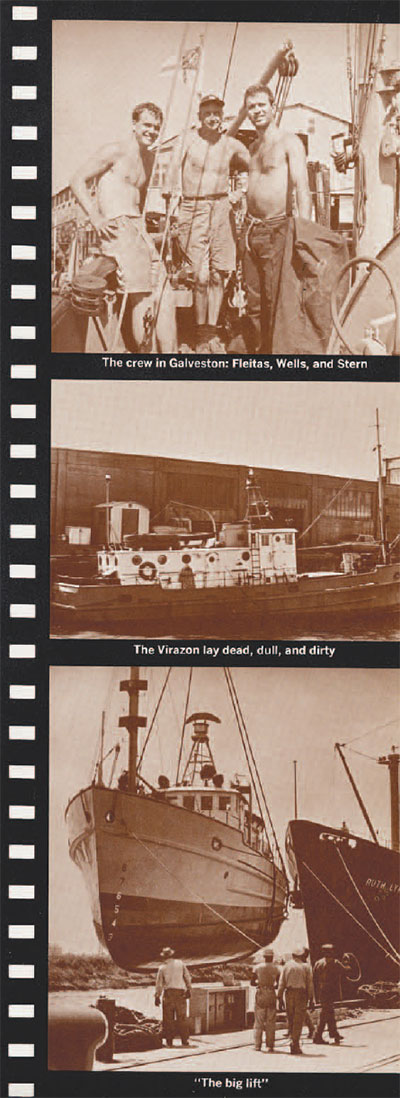
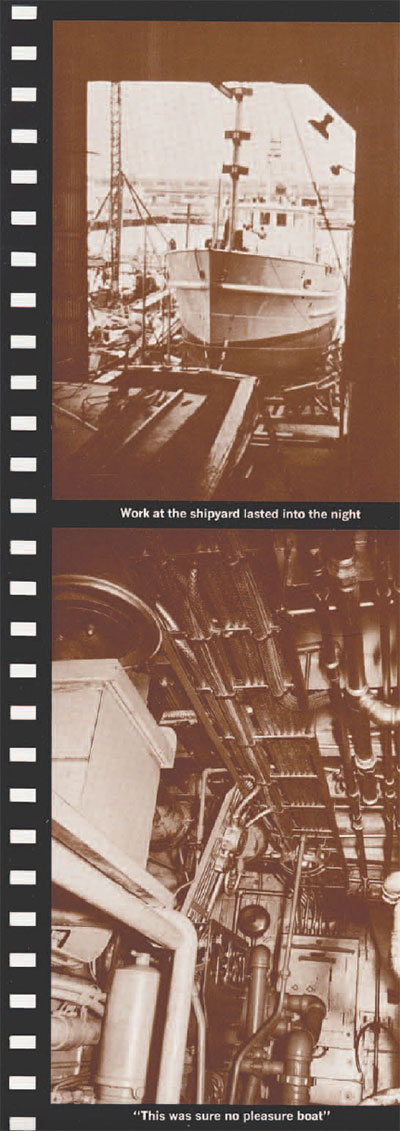
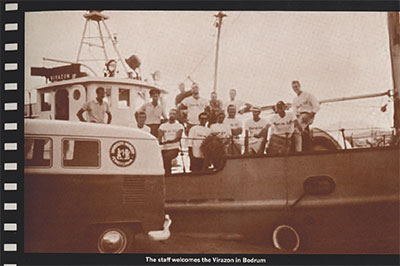
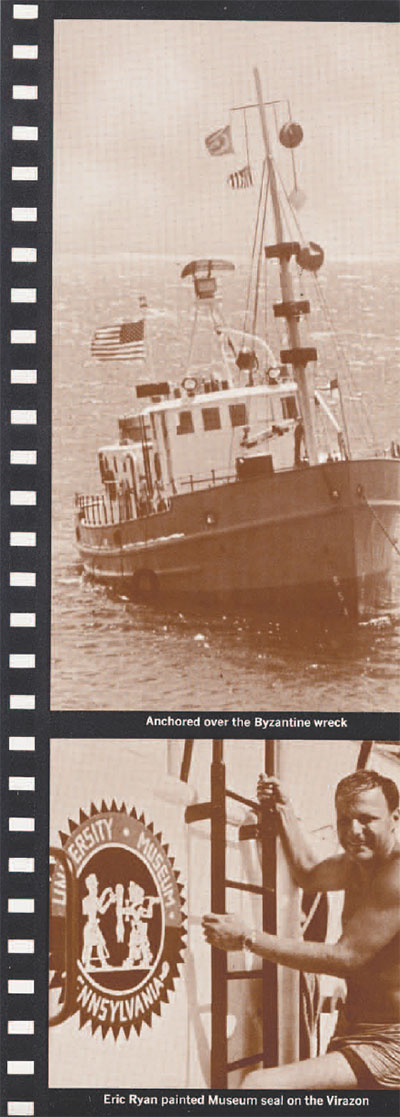
11 June 1964, 06:30 (Local Time, Galveston, Texas). It was chilly gazing down at the filth-littered water that lapped against the Nuclear Ship Savannah’s specially built pier at the Todd Shipyards, and certainly it wasn’t appealing, the raw sewage, garbage, and crude oil being tossed about on the wavelets of that muddy water. But then the job was to descend as rapidly as possible beneath the surface, lock the lifting harness to the keel of the Research Vessel Virazon, and get out quickly.
There was no one to blame but myself, for I had volunteered in a fit of enthusiasm. That had occurred in the warmth and comfort of a fashionable downtown club to which I had been invited by Mr. J.G. Tompkins and Mr. Stewart LeBlanc, Jr. These gentlemen, both dignitaries of the Lykes Brothers Steamship Company, had invited me to lunch to discuss the details of the shipment of the Virazon from Galveston to Piraeus, Greece. These two and their colleagues, had by this time done so much for the Museum and had been so downright generous that it seemed the least I could do to undertake this diving bit.
Now it was different. I shuddered and was thinking up excuses: typhoid, dysentery, yellow fever, bubonic plague. Certainly one of these horrors must be involved in that slime. But then, two weeks earlier, back in Philadelphia, I had been inflicted with “three or four dozen” shots, and in all honesty the plague had more to fear from me than I from it; there was no escape!
Aside from the natural elements, things were quiet. My two fellow crew members, both young men, had been up late and were not expected on deck for several hours. I climbed into the warmth of the pilot house to reconsider the whole affair.
This mounting crescendo had started on May 22nd when Dr. George F. Bass had received the “go-ahead” in the form of a letter from the National Science Foundation. An earlier conversation with Mr. James H. Wakelin, Jr., Assistant Secretary of the Navy for Research and Development, had led Dr. Bass to Dr. S. R. Galler of the Office of Naval Research, which had offered us the use of a 65-foot Navy T-boat. We needed the boat badly, to serve as the support ship for our new submarine Asherah, but this generous offer had raised two new problems–how to get her to Turkey, and how to finance her operation. The letter from the National Science Foundation informing us that the request for financial assistance had been granted, solved the latter problem, but there remained the question of how to get the boat across. Sail her across on her own bottom? Limited range! Add auxiliary tanks? No–too expensive and no time. Furthermore, she was not designed for open ocean operation…and her single engine was in questionable condition. How about “hitching” a lift aboard a large ship? It was just possible. Special lifting equipment would be needed. Cost? Maybe the Navy could help us if we could move some two thousand miles to Norfolk…time…crew…twenty-six things happened at once as we put fifty irons in the fire. And then J. Albury Fleitas, Secretary of the Corinthian Yacht Club of Philadelphia, put us in touch with the Lykes people. New problems kept appearing…the boat had lain in disuse for many months…would the engine turn over? Tbhe lines and running rigging were likely rotten! What equipment was needed? She was probably stripped. Cost…sailing directions…charts for the Aegean…how about a crew? And it was May 22nd.
Two days later, accompanied by Fleitas’ son, Sandy (who had volunteered to serve on the crew), I stood looking at the Virazon as she lay dead, dull, and dirty, disuse written all over her. Her dock lines half submerged in the filthy waters of Galveston Bay were coated with crude oil; soot blew along her decks, while rust outlined her fittings and structural members. We opened a deckhouse door, stepped into the interior, and descended through the fidley to the engine room. It was dank, dimly lit by our flashlight, and a loose screwdriver, rolled noisily on its shelf as the vessel rocked. This was sure no pleasure boat! Her main engine stood some five feet tall and measured more than eight feet fore and aft. I glanced at the morass of cables, pipes, shielded wire, and lines for compressed air, high-pressure steam, salt and fresh water, hot and cold water, oil and fuel, and shook my head. Here was a job for a shipyard and a professional crew, but even as the realization occurred I knew it was too late to back out.
We wired north for help and fell to work. Gerald Stern, mechanic par excellence, appeared the next day out of Boston. We towed the “dead” Virazon to a local shipyard where we worked from twelve to fourteen hours a day, aided by the yard personnel when we could afford them, and by specialized mechanics as the need occurred. We stripped the main engine down to her bearings, overhauled the controls and instrumentation, removed the major running rigging, repaired the navigational emergency and primary lighting systems, and conducted sea trials, including speed calibrations, in eighteen sweat-drenched days. We had moved the night before to our present position in the N/S Savannah‘s berth.
A movement to starboard caught my eye and I turned to see a towering black stack, marked with the “L” of the Lykes Company, advancing from behind a high, marsh-grass covered bank. I stepped on deck and from around the bend a bow appeared with the name Ruth Lykes painted in large white letters on the otherwise black hull.
The quiet of the past hour vanished as the shore crew descended by foor and vehicle to the pier. Longshoremen ranged along the Ruth to assist with the lines. Another team mounted the precipitous ladders that ascended “hundreds of feet” to the control cabin of the gigantic crane nearby. Small tractors pulled carts laden with line, fenders, and cables Supervisors appeared and quietly indicated directions.
Lawrence E. Schumacher, Tom M. McKenzie, Captain Ross M. Peterman, and Warren C. Eitelbach, all Lykes people, together with Carl Lippincott, General Manager of the Todd Company, assembled on the pier. These men had done the planning and arrangements. Newspapermen from Galveston and Houston came to picture the “big lift.” There had been some speculation a few days earlier regarding the reaction of the National Maritime Union to this project, in view of its unusual nature and our limited budget. A call to Fleitas in Philadelphia, who in turn called Mr. Joseph Curran, President of the Union in New York, put an end to speculation. Curran called Galveston and now, as I started toward the others, a longshoreman offered to carry my brief case. I have rarely in my life experienced such friendly cooperation from everyone concerned as was demonstrated throughout that day.
All forces being assembled, things started to happen fast. The gigantic crane moved forward on its tracks while a crew of men assembled the cables, shackles, and “baggywrinkle” which would comprise the harness. It seemed as though only a few minutes had elapsed, whereas in reality an hour had gone by before I could again look around objectively at the proceedings. During that time, however, another diver and I had secured the harness to the keel, and with it the first dive of the ’64 season was successfully completed. Slack had been taken from the harness and strain applied. The Virazon, some seventy-odd tons, was lifted with no apparent effort, conveyed down the dock, and raised up to the foredeck of the Ruth, where she rested, securely battened down.
–A month later we arrived in Piraeus.
I cannot describe the proceedings which led up to the unloading of our boat, nor can I recount the paper work which was involved simply because I just don’t know what happened. The fact of the matter is (which somehow surprised me) that those people speak GREEK. Defenseless, I could only rely on what I hoped would appear to be a friendly and pleasant countenance during the week of preliminaries. The technique was justified when I climbed aboard the lowered Virazon rocking gently alongside the freighter.
Into the pilot house and out with the United States ensign, which was raised smartly to its proper station. The Greek national ensign followed, as did the flag of the U.S. Power Squadron, and the burgee of the Corinthian Yacht Club of Philadelphia.
16 July, Zone Description-2, 10:33, the time had come. The Virazon operating under her own power maneuvered slowly down the channel, bound for Bodrum. Departure: group flashing light visible 19 miles. 975 R.P.M. Wind (est.) 15 knots; sea choppy. Arrived at Cape Tamelos 14 minutes late–southwesterly current greater than expected. Adjusted dead reckoning position and dropped the Isle of Kea astern. Wind and sea increasing! “SECURE ALL PORTS AND HATCHES!”
At first occasionally, and later regularly, white water welled up from the bows and, carried by the increasing wind, whipped astern. The boat moved violently underfoot, and I remembered the official description describing the Virazon as being intended for inland bays and sounds. Water was now constantly blowing over the pilot house, rendering the windshield wipers all but useless. We slowed down. Occasionally the wipers provided a glimpse through the cascading run-off and one could see the sun-lit, wave-lashed sea ahead. A glance at the “first mate” revealed a grim, jaw-set, little person hanging on for dear life, Jean and I had been through many similar occasions in our twenty years of married life and I knew how she hated them.
The log reads: “sea and wind increasing–abandoned course and navigated for comfort of crew…at about 17:00 Stern and Fleitas unable to stand watch.” By 18:00 we achieved a lee position behind Nisos Yioura and then ran for the shelter of Siros Harbor.
Blast the meltem! this wind from the northwest, sucked across the Aegean by the rising hot airs of the desert to the southeast. That breeze bettered 35 knots and I was too old for this. Tomorrow was another day. We’d get off at the crack of dawn and make our easting before the wind reached its stride. 05:30, 17 July (my mother’s birthday) and the breakwater lay well astern. Surprisingly, the sea had not abated over the night. It rolled in a crazy-quilt pattern of four to five feet, short-cycled waves. Ugh! Again we abandoned the direct course and adopted a course suited to the comfort of the ship. The crew, save for the “first,” did not appear for breakfast. I’ll admit that I kissed the “mate” when she brought hot coffee, bread, and cheese. Jean took the helm and I went to inspect the pounding of the engine room: pandemonium! The main battery banks, comprising two sets of seven heavy-duty batteries each, had parted their fastenings and were sliding back and forth, restrained only by the battery cables The tool-and-parts storage cabinet had broken open and equipment littered the steel plates which formed the walkways in the engine room. Beneath the flooring, oil-lade bilge water sloshed and splashed against the engine mounting brackets, while down the sides of the engine ran rivulets of water leaking from above, and lube oil oozed out from the pressure fittings. Jury-rig and repair, and aft to check the crew.
There was no crew: only two piles of protoplasm shivering miserably in the wet and fouled bedding that comprised their berths. The cabin was a litter of baggage, clothing, books, and gear, all soaking wet. An interior door banged open and shut, and the air was foul and hot. Back to the bridge to relieve the “mate.” We moved from behind one island to the next, making the most of the protection that each afforded. Toward mid-afternoon we reached a point from which we could alter course so as to take the sea astern and lay an approximate course for Yassi Ada. On the new course the ship steadied and the apparent wind dropped by some 15 knots. Two hours later a pair of haggard men appeared on the bridge; though feeling better they were a frightening spectacle. The mate made her way forward and somehow came up with a pot o’tea. We passed Yassi Ada where our camp lay as the sun set.
We brought Kos abeam well after dark. Applying a little left rudder the virazon swung to port and steadied the final leg with the lights of Bodrum just visible in the distance. The night was black and everything wet, the sea moderating but still rough, and everyone was cold and hungry. “My two boys” were feeling better, but their minds dwelt on their discomfort. “GO FORE AND AFT AND PREPARE THE DOCKING LINES”; activity is sometimes a good antidote to sea sickness. “Would you take the wheel for a few minutes, Sweetie? I’d like to collect myself before making harbor.” Things in our cabin were also littered about, some dishes having fallen from their racks, and there was leakage from beneath the icebox door, promising a further mess for him who would venture within. Sitting on the edge of the bunk I relaxed for a minute and then getting up wearily washed my hands and face. “Despite the chaos aboard we still represented the Museum, the University of Pennsylvania, and, by ‘The Grace’ we were an American flag vessel.” Corny? Perhaps. The idea somehow conveyed strength. I got out a clean shirt and black bow tie and put on my uniform. feeling better, I climbed back to the bridge. It wasn’t a moment too soon, for the jetty light of the Bodrum breakwater loomed in the middle darkness.
On with the main spotlight…there was the channel…slow down…strange harbor…any traffic?…is there a space at the wharf?…yes, there between the two caiques. “STAND BY THE FORWARD SPRING!” A few more contortions and we were secure.
A mass of faces illuminated by the green glare of our starboard running light peered up out of the darkness. Yes, there was George. “He looks well fed and rested, doesn’t he? And no doubt raring to go. Dammit!”
The assembling of the Museum’s fleet was only the beginning of perhaps the most profitable and promising season yet spent by our underwater research group in Turkey. Most of our efforts were devoted to completing the excavation of the seventh century Byzantine wreck on which we had been working since 1961. While the final stages of this work were in progress, it was possible for archaeologists to rest on the seabed in the Asherah, watching closely the consecutive teams of excavators during their short dives. The underwater communications system showed that instructions to the divers can be given from the submarine, thus assuring centralized and continuous direction on future operations. More important, some of the heavier work will not require divers at all. The maneuverability of the Asherah is so delicate that it will be possible to remove cargoes of amphoras with a simple hook below the submarine, and almost certainly it will also be possible to control a suction hose with a very simple, externally mounted mechanical arm. Such techniques, not attempted during this first, experimental season with a submarine, will allow excavation to continue around the clock on wrecks lying hundreds of feet deep.
Before a site may be excavated, however, it must be thoroughly mapped, and mapping is the most time-consuming phase of an underwater excavation. It was in this are that we expected, and received, the most from the Asherah. A pair of aerial survey cameras, encased in watertight housings, were mounted six feet apart on the front of the submarine. Specially ground lenses corrected the distortion normally caused by the index of refraction of water. Electric leads into the Asherah‘s pressure hull allowed the co-pilot to snap off pairs of stereophotographs at will; the cameras automatically advanced the film after each shot and re-cocked their shutters.
During one dive, the Asherah was “flown” in two passes over a Late Roman wreck lying in 140 feet of water. The co-pilot took a series of overlapping pairs of photographs on each pass, completely covering the site. Before an accurate plan with elevations could be made from these pictures, fifty-six hours of laboratory work with the instruments of Holland’s International Training Centre for Aerial Survey were needed. But the underwater work had taken less than half an hour! It would have taken a dozen archaeologists with Aqualungs, using the best mapping methods previously devised, many weeks of diving to do the same job.
The work at Yassi Ada is finished, but years of study remain for the evaluation of our findings. Meanwhile we will begin a search for new and equally productive sites. Where will we next assemble our fleet?
